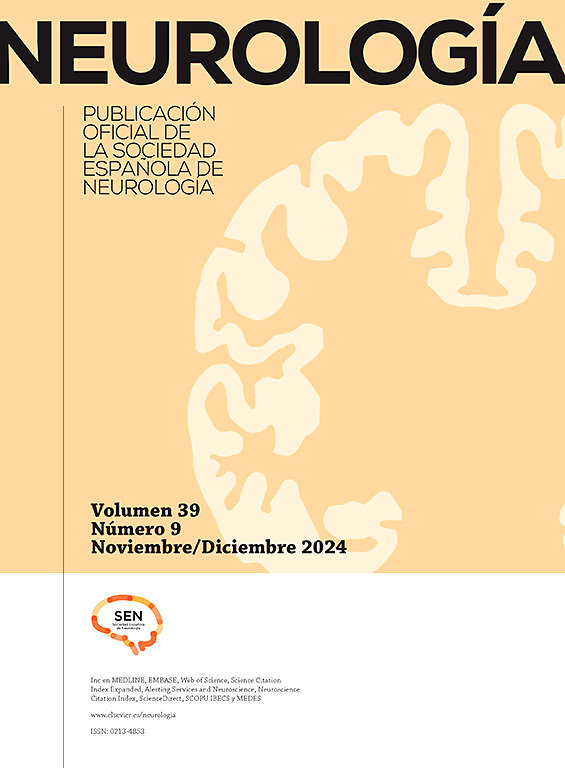评估脑电图在儿科急诊中的诊断效用
IF 3.1
4区 医学
Q2 CLINICAL NEUROLOGY
引用次数: 0
摘要
我们分析了在我们中心对16岁以下儿童进行紧急脑电图(EEG)诊断的实用性。材料和方法对2022年1月至12月期间因任何原因接受紧急脑电图检查的0至16岁连续患者进行描述性、回顾性、观察性研究。结果388例患者中,儿童70例,女性37例(52.85%),男性33例(47.14%)。平均年龄:6.27±4.809。70例患者中6例(8.57%)既往有癫痫病史。就诊原因:发热性癫痫17例,首发局灶性癫痫10例,首发TCG癫痫10例,阵发性发作6例,缺席6例,四肢肌阵挛3例,晕厥3例,SE 2例,视力改变2例,意识低下2例,紫绀2例,疑似脑膜炎或脑炎2例,窒息1例,非典型头痛1例,舞蹈病1例,晕厥前期1例,语言迟缓1例。70例患者脑电图正常47例(67.14%)。在47例脑电图正常的患者中,有10例被诊断为癫痫,其中3例出院后开始接受抗癫痫治疗。17例疑似晕厥或阵发性疾病患者(24.28%)无脑电图异常。17例非典型热性惊厥患者中,3例脑电图异常。结论在急诊科进行的脑电图记录中有三分之一出现了改变,可能是由于时间的原因。几乎一半的疑似癫痫或EE患者出现脑电图异常,这证实了这些病例的诊断,并鼓励临床医生开始药物治疗。在我们的研究中,没有一例高度怀疑癫痫的病例因脑电图记录正常而被驳回。诊断为晕厥或阵发性疾病的患者无脑电图异常。近四分之一的非典型热性惊厥患者出现脑电图异常。我们很少登记癫痫持续状态的病例,可能是由于我们中心的复杂性。本文章由计算机程序翻译,如有差异,请以英文原文为准。
Valoración de la utilidad diagnóstica del electroencefalograma en urgencias pediátricas
Introduction
We analyze the diagnostic utility of urgent EEG (electroencephalogram) performed in children under 16 years of age in our center.
Material and methods
Descriptive, retrospective, observational study of consecutive patients from 0 to 16 years of age, who underwent an urgent EEG for any reason, from January to December 2022.
Results
Of the 388 patients, 70 were children: 37 (52.85%) women, and 33 (47.14%) men. Average age: 6.27 ± 4.809. Of the 70 patients, 6 (8.57%) had previous epilepsy. Reasons for consultation: 17 febrile seizures, 10 first focal seizures, 10 first TCG seizures, 6 paroxysmal episodes, 6 absences, 3 myoclonus of extremities, 3 syncope, 2 SE, 2 visual alterations, 2 low level of consciousness, 2 cyanosis, 2 suspected meningitis or encephalitis, 1 choking, 1 atypical headache, 1 chorea, 1 presyncope, 1 language delay. Of the 70 patients, 47 had a normal EEG (67.14%). Of the 47 patients with a normal EEG, 10 were diagnosed with epilepsy, and 3 of them began receiving antiepileptic treatment upon discharge. None of the patients with suspected syncope or paroxysmal disorder (17 patients, 24.28%) had EEG abnormalities. Of the 17 patients with atypical febrile seizures, 3 had EEG abnormalities.
Conclusions
A third of the EEG records performed in the Emergency Department showed alterations, probably due to the time taken. Almost half of the patients with suspected epilepsy or EE showed EEG abnormalities, which confirmed the diagnosis in these cases and encouraged the clinician to start drug treatment. No case with a high suspicion of epilepsy was dismissed due to the normality of the EEG recording in our series. No patient diagnosed with syncope or paroxysmal disorder had EEG abnormalities. Nearly a quarter of patients with atypical febrile seizures showed EEG abnormalities. We barely register cases of status epilepticus, probably due to the degree of complexity of our center.
求助全文
通过发布文献求助,成功后即可免费获取论文全文。
去求助
来源期刊

Neurologia
医学-临床神经学
CiteScore
5.90
自引率
2.60%
发文量
135
审稿时长
48 days
期刊介绍:
Neurología es la revista oficial de la Sociedad Española de Neurología y publica, desde 1986 contribuciones científicas en el campo de la neurología clínica y experimental. Los contenidos de Neurología abarcan desde la neuroepidemiología, la clínica neurológica, la gestión y asistencia neurológica y la terapéutica, a la investigación básica en neurociencias aplicada a la neurología. Las áreas temáticas de la revistas incluyen la neurologia infantil, la neuropsicología, la neurorehabilitación y la neurogeriatría. Los artículos publicados en Neurología siguen un proceso de revisión por doble ciego a fin de que los trabajos sean seleccionados atendiendo a su calidad, originalidad e interés y así estén sometidos a un proceso de mejora. El formato de artículos incluye Editoriales, Originales, Revisiones y Cartas al Editor, Neurología es el vehículo de información científica de reconocida calidad en profesionales interesados en la neurología que utilizan el español, como demuestra su inclusión en los más prestigiosos y selectivos índices bibliográficos del mundo.
 求助内容:
求助内容: 应助结果提醒方式:
应助结果提醒方式:


